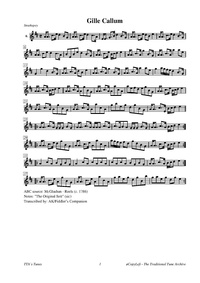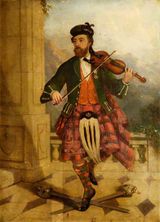Template:Pagina principale/Vetrina: Difference between revisions
No edit summary |
No edit summary |
||
| Line 1: | Line 1: | ||
{{SheetMusic | {{SheetMusic | ||
|f_track= | |f_track=Gillie Callum.mp3 | ||
|f_pdf= | |f_pdf=Gillie Callum.pdf | ||
|f_artwork= | |f_artwork=Sandyskinner.jpg | ||
|f_tune_name= | |f_tune_name=Gillie Callum | ||
|f_track_title= | |f_track_title=Gillie Callum | ||
|f_section= | |f_section=X1 | ||
|f_played_by=[https:// | |f_played_by=[https://soundcloud.com/user-300042645 Epiton] | ||
|f_notes= | |f_notes= James Scott Skinner's brother, Alexander "Sandy" Skinner, performing a sword dance while accompanying himself on the fiddle, c. 1880's. | ||
|f_caption= | |f_caption=Scottish tradition has it that it was first danced by a king of the Scots, Malcolm Canmore (O'Neill says the name is an English version of the Gaelic Callum a chinn mhoir, which "signifies as 'Callum of the big head'), in celebration of his victory at the Battle of Dunsinane in the year 1054. | ||
|f_source=[https:// | |f_source=[https://soundcloud.com/user-300042645/gillie-callum Soundcloud] | ||
|f_pix=420 | |f_pix=420 | ||
|f_picpix=200 | |f_picpix=200 | ||
|f_article=[[ | |f_article=[[Gillie Callum | '''Gillie Callum''']] | ||
One of the core tunes of Scottish repertoire, sometimes published (especially in older collections) with numerous variation sets. The earliest record of the tune is in David Young's '''Drummond Castle Manuscript, Part 2''' (1734, No. 10), in the possession of the Earl of Ancaster at Drummond Castle, sometimes called the '''Duke of Perth MS''' because of the inscription. Young also included the tune in one of his subsequent manuscript collections, '''The MacFarlane Manuscript, Part 2''' (c. 1740, No. 101, p. 236), albeit under the title "[[Cuttie Spoon]]." John Glen (1891) finds the reel in Robert Bremner's '''2nd Collection or Scots Reels or Country Dances''' (London, 1768, p. 108) under the title "Keelum Kallum taa fein." "Gillie Callum" retained its popularity into the next century, and J.S. Skinner, who was a dancing master as well as a celebrated violinist, taught the dance at such places as Elgin and Balmoral (where among other dances he had four children dance Gillie Callum "in a masterly style, such as has not been witnessed in this locality before"). | |||
}} | }} | ||
Revision as of 14:06, 6 May 2023

Played by: Epiton
Source: Soundcloud
Image: James Scott Skinner's brother, Alexander "Sandy" Skinner, performing a sword dance while accompanying himself on the fiddle, c. 1880's.

One of the core tunes of Scottish repertoire, sometimes published (especially in older collections) with numerous variation sets. The earliest record of the tune is in David Young's Drummond Castle Manuscript, Part 2 (1734, No. 10), in the possession of the Earl of Ancaster at Drummond Castle, sometimes called the Duke of Perth MS because of the inscription. Young also included the tune in one of his subsequent manuscript collections, The MacFarlane Manuscript, Part 2 (c. 1740, No. 101, p. 236), albeit under the title "Cuttie Spoon." John Glen (1891) finds the reel in Robert Bremner's 2nd Collection or Scots Reels or Country Dances (London, 1768, p. 108) under the title "Keelum Kallum taa fein." "Gillie Callum" retained its popularity into the next century, and J.S. Skinner, who was a dancing master as well as a celebrated violinist, taught the dance at such places as Elgin and Balmoral (where among other dances he had four children dance Gillie Callum "in a masterly style, such as has not been witnessed in this locality before").
...more at: Gillie Callum - full Score(s) and Annotations
X:1 T:Giliecallum M:C| L:1/8 R:Reel B:David Young - The Drummond Castle Manuscript, Part 2 (1734, No. 10) B:https://www.cl.cam.ac.uk/~rja14/musicfiles/manuscripts/drummond2.pdf Z:AK/Fiddler's Companion K:Amix V:1 clef=treble name="1." [V:1] AATcA c/d/e (BG)|AATcA c/d/e T(cA)|EETcA c/d/e (BG)|ABcA dB e2:| |:AATcA g2 (BG)|AATcA aa b/a/g/f/|gg a/g/f/e/ dgBG|ABcA dB e2:| |:A/A/A/A/ TcA d/d/d/d/ BG|A/A/A/A/ TcA e/e/e/e/ TcA|e/e/e/e/ TcA d/d/d/d/ BG|ABcA dB e2:| |:AATcA B/d/g (BG)|AATcA c/e/a T(cA)|c/e/a (cA) B/d/g (BG)|ABcA dB e2:| |:eATcA dG B/c/d/B/|eATcA eAfA|eATcA dG B/c/d/B/|ABcA dBe2:| |:aeTcA gdBG|aeTcA aAaf|gg a/g/f/e/ dgBG|ABcA dB e2:| |:ABcA dB G/A/B/G/|AECA, B,DB,G,|AEBE dB G/A/B/G/|ABcA dB e2:| |:efTcA deBG|A/B/c/d/ eA aA c/d/e/f/|gg a/g/f/e/ dgBG|ABcA dB e2:| |:Aece deBG|Aece dece|dece deBG|ABcA dB e2:| |:Aaca dgBG|Aaca Aaca|Aaca dgBG|ABcA dB e2:|]
